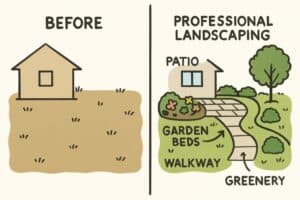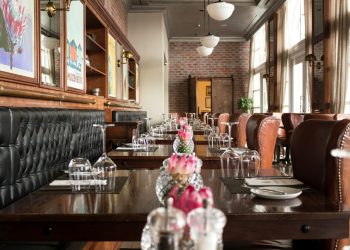Table of Contents
- Introduction
- Assessing Your Current Landscape
- Incorporating Hardscaping Elements
- Enhancing with Softscaping
- Adding Water Features
- Utilizing Vertical Spaces
- Regular Maintenance for Lasting Beauty
- Conclusion
Introduction
Is your outdoor area failing to inspire relaxation and enjoyment? It’s common for homeowners to feel overwhelmed by tired, uninspired gardens or neglected lawns. When you don’t know where to begin or how to maximize your yard’s potential, seeking the help of a landscape designer can make all the difference. With a seasoned eye and expert planning, your drab outdoor space can be reimagined into a stunning, functional extension of your home.
Investing in professional landscape design not only enhances the beauty of your property but also increases its value and usability. From reworking the structure to adding unique features, this guide explores the steps and benefits of transforming your yard from dull to delightful with expert help.
Assessing Your Current Landscape
Every successful landscape transformation starts with a thoughtful assessment. Carefully observe your yard to pinpoint areas that need attention—such as worn-out lawn patches, overgrown shrubs, or outdated garden features. Make notes about where sunlight hits, drainage issues, and how you currently use the space. These observations are crucial in shaping a redesign that suits both your lifestyle and your environment.
A professional designer takes this process further with a site analysis, considering factors such as soil quality, existing plants, and practical needs, including privacy and play areas. Their expertise helps ensure underlying problems are addressed and that all improvements are long-lasting.
Incorporating Hardscaping Elements
The backbone of any great outdoor space lies in its hardscaping—the non-living features that give structure and functionality. Hardscaping can include patios for entertaining, walkways for navigation, and retaining walls to manage sloped terrain. For a deeper dive into the elements and benefits of hardscaping, see this guide from HowStuffWorks: Hardscaping Basics. For example, a well-placed stone pathway can guide guests through your garden, while a patio with seating transforms a once-unused corner into a lively social hub.

Hardscaping isn’t just about aesthetics; it supports the overall function of your landscape, prevents erosion, and helps define different “rooms” within your garden.
Enhancing with Softscaping
Softscaping, which encompasses all the living elements of your yard, adds movement and color to the structured framework provided by hardscaping. The right selection of plants, trees, and shrubs can create a rich tapestry that evolves through each season. Native plants are particularly advantageous because they are adapted to your climate, supporting pollinators while reducing water and maintenance needs.
Collaboration with an experienced designer is key here—they select appropriate species based on your sun exposure, soil, and desired look. Thoughtfully designed beds of perennial flowers or statement trees can transform any bland lawn into a thriving ecosystem, and incorporating edible landscaping is also a fun and sustainable option for many homeowners.
Adding Water Features
To elevate your outdoor environment, consider integrating water features such as fountains, ponds, or even a simple birdbath. The gentle trickle of water muffles street noise, introducing a sense of tranquility and encouraging visits from local wildlife, such as birds and butterflies.
Adding water features doesn’t have to be complicated or expensive. Features can range from a grand koi pond to a modest recirculating tabletop fountain. No matter the size, water elements can transform the average garden into a peaceful retreat that refreshes the senses. For ideas on water feature styles, visit this comprehensive resource on Garden Design.
Even a minor water feature can make a big impact on your garden’s ambiance. Incorporating plants around the water enhances its natural appeal and provides a welcoming habitat for wildlife.
Utilizing Vertical Spaces
Outdoor areas are not limited to the ground alone. Creative use of vertical space multiplies the visual impact of smaller yards and brings drama to any garden. Options like trellises, arbors, pergolas, and living walls provide support for climbing plants, drawing the eye upward and making spaces feel larger and more dynamic.
Vining plants such as clematis, jasmine, and climbing roses are ideal for adorning bare fences or walls. For patios or balconies, vertical planters can introduce herbs, vegetables, or succulents in an organized and striking display, maximizing every inch of your landscape.
Regular Maintenance for Lasting Beauty
Ongoing maintenance preserves the investment and enjoyment of your revitalized yard. Routine tasks such as mowing, pruning, mulching, and sprinkling ensure that both plants and hardscape components remain in top shape.
A knowledgeable landscape designer can develop a customized maintenance schedule for your specific plantings and features, guiding you on seasonal needs, pest prevention, and timely upgrades. With proper care, your yard will continue to flourish, providing beauty and value for years to come.
Conclusion
A once dull and uninspiring yard can easily become the highlight of your home with the help of an expert landscape designer. By evaluating your current landscape, embracing both hardscaping and softscaping, incorporating water features, utilizing vertical space, and following a tailored maintenance plan, you unlock the full potential of your outdoor space. The transformation is not only visually striking but also functional and sustainable, bringing renewed joy every time you step outside.


